-
 Bitcoin
Bitcoin $115200
-2.68% -
 Ethereum
Ethereum $3601
-5.16% -
 XRP
XRP $3.035
-2.96% -
 Tether USDt
Tether USDt $0.9997
-0.04% -
 BNB
BNB $764.5
-5.43% -
 Solana
Solana $168.1
-5.92% -
 USDC
USDC $0.9998
-0.02% -
 Dogecoin
Dogecoin $0.2090
-4.80% -
 TRON
TRON $0.3272
-0.49% -
 Cardano
Cardano $0.7306
-5.00% -
 Hyperliquid
Hyperliquid $39.16
-12.22% -
 Stellar
Stellar $0.3967
-4.96% -
 Sui
Sui $3.566
-5.95% -
 Chainlink
Chainlink $16.55
-6.57% -
 Bitcoin Cash
Bitcoin Cash $552.3
-3.90% -
 Hedera
Hedera $0.2516
-4.69% -
 Avalanche
Avalanche $21.99
-5.75% -
 Toncoin
Toncoin $3.621
-0.28% -
 Ethena USDe
Ethena USDe $1.000
-0.03% -
 UNUS SED LEO
UNUS SED LEO $8.951
0.02% -
 Litecoin
Litecoin $105.9
-3.59% -
 Shiba Inu
Shiba Inu $0.00001232
-5.00% -
 Polkadot
Polkadot $3.640
-5.55% -
 Uniswap
Uniswap $9.048
-7.03% -
 Monero
Monero $301.8
-1.51% -
 Dai
Dai $0.9999
-0.01% -
 Bitget Token
Bitget Token $4.334
-3.66% -
 Pepe
Pepe $0.00001064
-6.17% -
 Cronos
Cronos $0.1367
-5.78% -
 Aave
Aave $259.2
-4.59%
What is the difference between StochRSI and RSI? Which one is more suitable for short-term trading?
RSI measures price momentum over time, while StochRSI, more sensitive, applies Stochastic to RSI for short-term trading signals in cryptocurrency markets.
May 25, 2025 at 08:07 pm

Understanding RSI
The Relative Strength Index (RSI) is a momentum oscillator that measures the speed and change of price movements. Developed by J. Welles Wilder, RSI is typically used to identify overbought or oversold conditions in the market. The RSI is calculated based on the average gain and loss of an asset over a specified period, usually 14 days. The formula for RSI is as follows:
[ \text{RSI} = 100 - \frac{100}{1 + \text{RS}} ]
Where RS (Relative Strength) is the average of 'n' days' up closes divided by the average of 'n' days' down closes.
The RSI ranges from 0 to 100. Traditionally, an RSI value above 70 indicates that an asset may be overbought, while a value below 30 suggests it may be oversold. Traders often use these thresholds to make buy or sell decisions.
Understanding StochRSI
Stochastic RSI (StochRSI) is a technical indicator that applies the Stochastic oscillator formula to RSI values instead of price values. This creates a more sensitive indicator that oscillates between 0 and 1. The StochRSI is calculated using the following steps:
- Calculate the RSI over a specified period.
- Use the RSI values to calculate the StochRSI using the Stochastic oscillator formula:
[ \text{StochRSI} = \frac{\text{RSI} - \text{RSI}{\text{min}}}{\text{RSI}{\text{max}} - \text{RSI}_{\text{min}}} ]
Where (\text{RSI}{\text{min}}) and (\text{RSI}{\text{max}}) are the lowest and highest RSI values over the look-back period, respectively.
The StochRSI ranges from 0 to 1. Similar to RSI, traders use overbought and oversold levels to make trading decisions. Commonly, a StochRSI value above 0.8 is considered overbought, and a value below 0.2 is considered oversold.
Key Differences Between RSI and StochRSI
The primary difference between RSI and StochRSI lies in their sensitivity and range. RSI is less sensitive and moves more slowly, while StochRSI is more sensitive and can fluctuate rapidly between 0 and 1. This sensitivity makes StochRSI better suited for identifying short-term market conditions.
RSI measures the momentum of price movements, providing a broader view of market conditions over a set period. In contrast, StochRSI measures the momentum of the RSI itself, which can lead to more frequent trading signals.
Using RSI for Short-Term Trading
When using RSI for short-term trading, traders typically look for the following signals:
- Overbought and Oversold Conditions: RSI values above 70 indicate overbought conditions, suggesting a potential sell signal. Conversely, RSI values below 30 indicate oversold conditions, suggesting a potential buy signal.
- Divergence: If the price of an asset is making new highs while the RSI is failing to make new highs, it could indicate a bearish divergence and a potential reversal. Similarly, if the price is making new lows while the RSI is not, it could signal a bullish divergence.
- Failure Swings: These occur when the RSI surpasses a previous high (bullish failure swing) or falls below a previous low (bearish failure swing), indicating a potential trend reversal.
Using StochRSI for Short-Term Trading
StochRSI is particularly useful for short-term trading due to its sensitivity. Traders can use the following strategies:
- Overbought and Oversold Levels: When the StochRSI rises above 0.8, it may signal that the asset is overbought, and a sell signal could be considered. When the StochRSI falls below 0.2, it may indicate that the asset is oversold, and a buy signal could be considered.
- Crossovers: Traders can look for the StochRSI to cross above or below its moving average (often a 3-day simple moving average) as a signal to buy or sell.
- Divergence: Similar to RSI, traders can look for divergences between the StochRSI and the price of the asset. If the price is making new highs while the StochRSI is not, it could signal a bearish divergence. Conversely, if the price is making new lows while the StochRSI is not, it could indicate a bullish divergence.
Which Indicator is More Suitable for Short-Term Trading?
StochRSI is generally more suitable for short-term trading due to its higher sensitivity and ability to generate more frequent signals. The rapid oscillations of StochRSI allow traders to capture short-term price movements more effectively than the slower-moving RSI.
However, RSI can still be valuable for short-term trading when used in conjunction with other indicators or when traders are looking for slightly longer-term signals. The choice between RSI and StochRSI ultimately depends on the trader's strategy and risk tolerance.
Practical Application of RSI and StochRSI in Cryptocurrency Trading
To illustrate how these indicators can be used in cryptocurrency trading, consider the following example:
Using RSI:
- Suppose you are trading Bitcoin (BTC) and notice that the RSI has risen above 70. This could indicate that BTC is overbought, and you might consider selling or taking profits.
- Conversely, if the RSI falls below 30, it could signal that BTC is oversold, and you might consider buying or increasing your position.
Using StochRSI:
- If you are trading Ethereum (ETH) and see the StochRSI rise above 0.8, it may suggest that ETH is overbought, and a sell signal could be considered.
- If the StochRSI falls below 0.2, it may indicate that ETH is oversold, and a buy signal could be considered.
Frequently Asked Questions
Q1: Can RSI and StochRSI be used together in trading strategies?
- Yes, RSI and StochRSI can be used together to enhance trading strategies. For instance, a trader might use RSI to identify broader market conditions and StochRSI to pinpoint more precise entry and exit points. This combination can provide a more comprehensive view of market momentum and potential reversals.
Q2: How do I set up RSI and StochRSI on a trading platform?
- Setting up RSI and StochRSI on a trading platform typically involves the following steps:
- Open your trading platform and select the asset you want to analyze.
- Navigate to the indicators or studies section of the platform.
- Search for RSI and add it to your chart, adjusting the period to your preference (commonly 14 days).
- Search for StochRSI and add it to your chart, adjusting the period and look-back period as needed.
- Customize the overbought and oversold levels for both indicators according to your trading strategy.
Q3: Are there any common pitfalls to avoid when using RSI and StochRSI?
- One common pitfall is relying solely on these indicators without considering other factors such as market trends, volume, and other technical indicators. False signals can occur, especially in highly volatile markets like cryptocurrencies. It's crucial to use RSI and StochRSI in conjunction with other tools and to practice risk management.
Q4: How do different time frames affect the performance of RSI and StochRSI?
- The performance of RSI and StochRSI can vary significantly across different time frames. Shorter time frames (e.g., 5-minute or 15-minute charts) can lead to more frequent signals and increased sensitivity, which is beneficial for short-term trading. Longer time frames (e.g., daily or weekly charts) provide a broader view of market conditions and are more suitable for longer-term trading strategies. Traders should experiment with different time frames to find what works best for their specific trading goals.
Disclaimer:info@kdj.com
The information provided is not trading advice. kdj.com does not assume any responsibility for any investments made based on the information provided in this article. Cryptocurrencies are highly volatile and it is highly recommended that you invest with caution after thorough research!
If you believe that the content used on this website infringes your copyright, please contact us immediately (info@kdj.com) and we will delete it promptly.
- Litecoin Price Watch: UNIL Pump & Staking Success Steal the Show?
- 2025-08-02 02:50:12
- Bitcoin, Crypto, Gambling Sites: 2025's Hottest Trends and Where to Bet
- 2025-08-02 02:50:12
- FTX Token's Wild Ride: FTT Drop Amidst Creditor Repayment Buzz
- 2025-08-02 01:30:12
- Navigating the Crypto Market: Bitcoin, Trader Experience, and Avoiding the Noise
- 2025-08-02 00:50:12
- Deep Agents, AI Task Management, and Evolution AI: A New Era?
- 2025-08-02 00:50:12
- AAVE Price Under Pressure: Technical Indicators Point to Bearish Momentum
- 2025-08-02 02:10:12
Related knowledge

What is the lifecycle of a blockchain transaction?
Aug 01,2025 at 07:56pm
Initiation of a Blockchain TransactionA blockchain transaction begins when a user decides to transfer digital assets from one wallet to another. This ...

What is the block creation process?
Aug 02,2025 at 02:35am
Understanding the Block Creation Process in CryptocurrencyThe block creation process is a fundamental mechanism in blockchain networks that enables th...

How do I secure my private key?
Aug 01,2025 at 05:14pm
Understanding the Importance of Private Key SecurityYour private key is the most critical component of your cryptocurrency ownership. It is a cryptogr...

What is a 51% majority attack?
Aug 01,2025 at 09:15pm
Understanding the Concept of a 51% Majority AttackA 51% majority attack occurs when a single entity or group gains control over more than half of a bl...

Why is the J line often considered the "signal" line in the KDJ indicator?
Aug 01,2025 at 07:28pm
Understanding the KDJ Indicator StructureThe KDJ indicator is a momentum oscillator widely used in cryptocurrency trading to identify overbought and o...

What does a divergence between the K and D lines signify?
Aug 01,2025 at 06:49pm
Understanding the Stochastic Oscillator and Its ComponentsThe Stochastic Oscillator is a momentum indicator widely used in cryptocurrency trading to a...

What is the lifecycle of a blockchain transaction?
Aug 01,2025 at 07:56pm
Initiation of a Blockchain TransactionA blockchain transaction begins when a user decides to transfer digital assets from one wallet to another. This ...

What is the block creation process?
Aug 02,2025 at 02:35am
Understanding the Block Creation Process in CryptocurrencyThe block creation process is a fundamental mechanism in blockchain networks that enables th...

How do I secure my private key?
Aug 01,2025 at 05:14pm
Understanding the Importance of Private Key SecurityYour private key is the most critical component of your cryptocurrency ownership. It is a cryptogr...

What is a 51% majority attack?
Aug 01,2025 at 09:15pm
Understanding the Concept of a 51% Majority AttackA 51% majority attack occurs when a single entity or group gains control over more than half of a bl...

Why is the J line often considered the "signal" line in the KDJ indicator?
Aug 01,2025 at 07:28pm
Understanding the KDJ Indicator StructureThe KDJ indicator is a momentum oscillator widely used in cryptocurrency trading to identify overbought and o...

What does a divergence between the K and D lines signify?
Aug 01,2025 at 06:49pm
Understanding the Stochastic Oscillator and Its ComponentsThe Stochastic Oscillator is a momentum indicator widely used in cryptocurrency trading to a...
See all articles

























































































